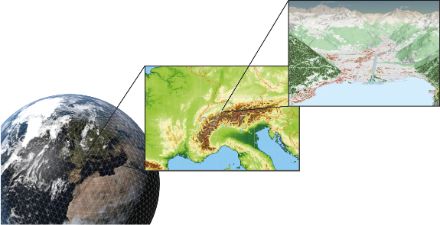Service Navigation
Search
Accurate, timely, and tailored weather forecasts underpin decision making across many sectors, especially for extreme events like floods and storms, where they can help save lives and protect livelihoods. To issue warnings and provide support for forecast-based decisions, forecast information for extreme events such as strong (thunder)storms and rain showers need to be delivered promptly, with adequate precision, and linked to likely impacts and vulnerabilities. Forecast-based Early Warning Systems have demonstrated significant cost-effectiveness and efficacy, but they require the integration between what the weather will be (forecasts), what it will do (impacts), and how we will be affected (vulnerability).
GLORI-A - a digital twin of the earth with focus on the Alpine region - aims to address this gap. The Alpine Twin will facilitate a seamless connection between weather forecasts for parameters such as, e.g. precipitation, and the related impacts on energy systems, urban environments, agriculture, and others. It will build on the existing forecasting system ICON, but will feature enhanced capabilities, such as higher model resolution, which is especially important in the complex mountainous terrain of the Alps. Selected use cases of flood forecasting (precipitation), energy production (wind, sunshine duration, Saharan dust events) or health applications (air pollution, heat) will demonstrate the improved quality and usability of the forecast.
GLORI-A is part of the tri-lateral collaboration GLORI, bringing together the national weather services of Germany, Italy, and Switzerland, as well as research institutes of these three countries, to improve availability of and access to cutting-edge weather and extremes forecasting data for decision-making.

The GLORI-A Digital Twin will be a configurable on-demand global-to-regional short-range high-resolution digital twin based on the prediction capability of ICON.
What does this mean?
- Configurable and on-demand: The data generated by the digital twin will be accessible to users with different needs and data access can be adjusted by the user both in type and frequency of tailored forecast for different applications such as floods, air pollution, storms and others.
- Global-to-regional: Based on the prediction capacity of the ICON weather and climate model, the digital twin can be used to make weather predictions for the whole world, as well as more detailed predictions for specific regions like the Alps or the Mediterranean.
- Short-range: GLORI-A aims at improving the quality of short-range forecasts up to one week. It therefore aims at forecasting imminent events and weather conditions, with a focus on extreme events at kilometer-scale resolution, like extreme precipitation and storms.
- High-resolution: The digital twin can make very detailed weather predictions because it uses a new generation of supercomputers such as the Alps computer at CSCS. Currently, the global ICON model is run at a resolution of 13 km, while the operational ICON configuration at MeteoSwiss will provide forecasts with a mesh-size of 1 km. The GLORI-A project will start with this baseline and refine the horizontal resolution for the regional twins to up to 500 m mesh-size. This will for example significantly increase forecasting skill for large Alpine valleys like the upper Rhône and Rhine valleys.
- Digital Twin: In the context of weather modelling, the digital twin is a simulation of the weather that is designed to be as realistic as possible. It provides the opportunity to make simulations on the specific scenario needed by the user for their specific application and includes socio-economic data which permits forecasting of impacts.
Project organization
The project GLORI is a collaboration of nine institutions in three countries: Germany, Italy, and Switzerland. Each country is involving their National Meteorological Service, as well as other research partners and computing centers.
